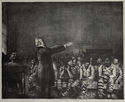
19th, 20th & 21st Century Fine Prints
707-546-7352 · fax 707-546-7924 · web: www.annexgalleries.com · email: artannex@aol.com
George Wesley Bellows Biography
George Wesley Bellows
American
1882–1925
Biography
Painter and printmaker George Wesley Bellows was born in Columbus, Ohio in 1882, the only child of George and Anna Bellows. Young Bellows was primarily a self-taught artist, discovering a love for drawing before he began elementary school.
His early years were spent divided between his two main interests: sports and art. Baseball and basketball carried him through high school and he played semipro baseball after graduation. Though he was approached by a scout from Indianapolis, he decided to enroll at Ohio State University in 1901. He continued to play while also illustrating the school paper and beginning work as a commercial artist. Despite these successes, Bellows realized he wanted to focus on painting as a career. He was nearly finished with his four years at Ohio State when he left for New York to pursue this path.
In Manhattan Bellows met artist Robert Henri, who taught at the New York School of Art. Bellows was drawn to Henri's approach to art and subject matter: pulling away from the emphasis on classical technique and subjects, and using bolder, more immediate techniques to illuminate the everyday lives of the working class. This style, honed by Henri, Bellows, and others, would become known as American Realism, the group known as the Ashcan School. Additionally, Bellows was a regular visitor to the Metropolitan Museum of Art, where he studied Old Masters. In 1911 the museum purchased one of his works, "Up the Hudson", making him one the youngest artist to have a work obtained by the prestigious institution.
He opened his own studio in 1906, and two years later he exhibited as part of Henri's show entitled "The Eight", in a protest against the National Academy of Design's strict, conservative guidelines for what was considered high art. Critical praise of Bellows' work established him as a formidable figure in the new wave of socially and politically charged art, setting the stage for his work with "The Masses" socialist journal, as well as an independently published series of lithographs criticizing Germany's invasion of Belgium and America's role in World War I.
In 1909 he taught at the Art Students League of New York, but continued to pursue painting as his sole career, entering juried exhibitions and garnering recognition as a studio artist. In addition to portraying the grit of the boroughs and streets of New York, he began to paint images of sportsmen, primarily amateur boxers. These would eventually become among his most recognized works, in both painting and lithography. In 1919 he taught at the Art Institution of Chicago; beginning in 1920 he spent half the year in Woodstock, building a home for his family. Between 1921 and 1924 Bellows collaborated with master printmaker Bolton Brown to create over one hundred lithographs.
George Bellows died in New York on January 18, 1925, from complications from a ruptured appendix.




